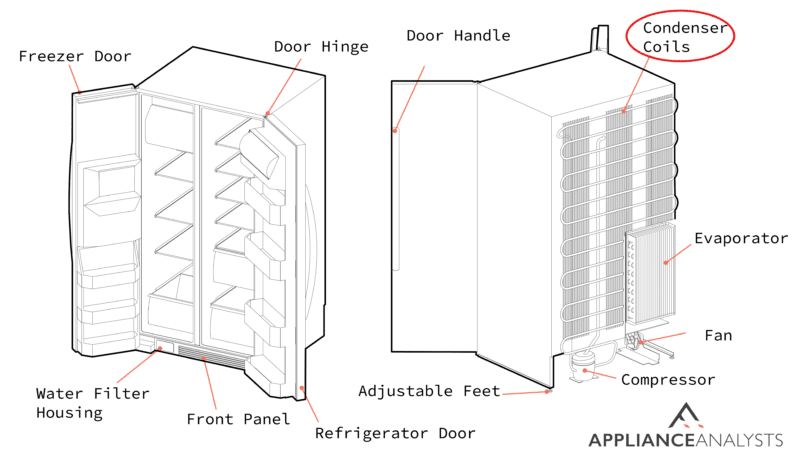You’ve tried everything, and your refrigerator won’t turn on?
You’re not alone! Refrigerators are a key element to every modern kitchen, so having yours fail can be very frustrating.
There are a million and one reasons why your fridge just quit freezing and cooling your food. If your fridge won’t turn on, your first focus should be the power supply. Check whether you’ve inserted the plug properly or if the circuit breaker has tripped. Provided everything seems okay with the power supply, you must focus on a faulty wiring, capacitor, thermostat, coolant shortage, compressor, or motor.
In the following article, we’ll look at some of the most common reasons your fridge is acting up and go over 6 simple steps to fix the problem. I’m sure that by the end of this piece, you’ll have fixed your fridge like a pro!
Ready? Let’s dive in!
Why trust us? This article was written by Craig Anderson and Andy Fulenchek.
Craig has helped thousands of other homeowners repair their appliances since 2016.
Andy is one of our resident appliance repair experts with over a decade of experience. He currently runs his appliance repair company with a team of trusted technicians.
Why Your Refrigerator Won’t Turn On
If your fridge isn’t turning on, there are several possibilities that must be taken into account to troubleshoot the issue. Here are some of the things I recommend you check first.
A Circuit Breaker Overload
In my experience, when your fridge won’t turn on, no matter what you try, the circuit breaker can be the culprit. Check whether the breaker has tripped and reset it if so.

While refrigerators don’t draw a lot of power, they can still cause a circuit overload if there’s an issue present in their wiring. You should also check that the refrigerator is not plugged into a GCFI outlet (Ground Fault Circuit Interrupter), as they’re common in kitchens.
My usual advice is to try unplugging your refrigerator and plugging another appliance into the outlet you normally use to rule out a faulty outlet as the culprit.
A Faulty Compressor
If your refrigerator won’t turn on and you’ve ruled out power supply issues, a faulty compressor could be to blame.
The compressor is the heart of the refrigerator, as it’s responsible for the continuous refrigeration cycle. If the fridge doesn’t work, your compressor may be faulty. The compressor compresses the refrigerant or coolant and circulates it through the evaporator and condenser coils within the fridge.

Insufficient Current
A bad outlet or a damaged power cord could also explain a fridge that won’t turn on. To rule out insufficient voltage, check the power cord for damage, and use a multimeter to test the wall outlet you normally use.
Problems With the Motor
A defective motor is another common problem that causes a fridge that’s not turning on. Defective motors have to be replaced immediately, as I find waiting too long can cause further damage. Please get in touch with a technician you trust as soon as you suspect there’s something wrong with your refrigerator’s motor.
Dirty Condenser Coils
Failing to clean the condenser coils is also a common reason when a fridge won’t turn on.
The condenser coils have a critical role to play in running your refrigerator. The coils are located at the back of the appliance, always exposed to heat, dust, and humidity.
Condenser coils convert high-pressure temperature gas into high-pressure liquid. The process dissipates a lot of heat from the rear end, which means the coils are susceptible to dirt and other environmental elements. From what I’ve seen over the years, when covered in dirt, the condenser coils may not work efficiently, which often leads to an abrupt breakdown of the fridge.

Damaged Start Capacitor
Every time you turn on your fridge, multiple mechanical processes take place, and they start with the start capacitor. When you switch ON the appliance, the thermostat sends a message to the start capacitor to trigger the compressor and begin the refrigeration cycle.

When the capacitor fails, there will be no refrigeration cycle, and in most cases, the fridge won’t turn on. Your trusted technician can help you determine whether to repair or replace the capacitor.
Faulty Thermostat
A faulty thermostat is also a common culprit when a refrigerator is not turning on.
Bad thermostats cause a series of problems with the entire functioning of your fridge. When defective, the thermostat will fail to communicate with the start capacitor, and the refrigerator won’t turn on or cool.
If you want to get any replacement part – or see how much one would cost – click to enter your model number in the search bar below. Our partners at AppliancePartsPros stock almost every part with free guides on how to install them.

Fixing a Refrigerator that Won’t Turn On: 6 Steps
Now that you know the most common reasons why your refrigerator is not turning on, let’s move on to what you can do about the situation.
#1 Turn the Fridge off and Then on (If the Fridge Has a Switch)
To check whether there’s a problem with your refrigerator, turn it off and then on again by using the power switch (not all fridges have them). If your refrigerator doesn’t have an on/off switch, unplug the power cord and plug it on again. If you have connected the cord to an extension, try plugging it directly into the wall outlet.
#2 Inspect/Replace the Power Cord
Although refrigerator power cords are sturdy, damage to yours could explain why your fridge won’t turn on.
If you keep the power cord tangled or pressing against the wall at a sharp angle, you might have broken some tiny cables inside the cord’s larger housing, cutting off proper electrical flow.
When the damage is total, your refrigerator won’t turn on, but when it’s partial, the cord can still send small signals that cause short-circuiting. If you suspect your refrigerator’s power cord to be damaged, my usual advice is to stop using the appliance until you’ve replaced the cord.
#3 Check the Circuit Breaker
Your fridge is a large unit capable of tripping the circuit breaker assigned to it. It’s critical to rule out overloading before opening your refrigerator. Most homes have a dedicated 20 -amp circuit breaker for the fridge alone, but older homes may have it on the general kitchen circuit.
- Find the breaker box and open the cover.
- Check whether there’s any breaker in the OFF position.
- If so, chances are your fridge caused an overload. To be sure, turn off and unplug everything else connected to the tripped breaker and move the lever from OFF to ON.
If the breaker trips again, either the fridge is causing the overload or the breaker is faulty. Check what else could be plugged into the same circuit to pinpoint the overload’s source. If the breaker doesn’t trip and remains in the ON position, the solution below will likely help.
#4 Test for Overload Relay
The overload relay in your refrigerator is the protection device used to start the winding before the compressor begins running at the required speed. The relay is like the Presidential Secret Service, which leads the way every time the president travels. The relays come with a capacitor that offers the high start voltage required by the compressor winding.
The overload relay can be found on the side of the compressor. You can check the overload relay using your multimeter. To do so, ensure you’ve unplugged your refrigerator, then:
- Remove the rear panel and locate the relay start capacitor (it’s on the side of the compressor).
- Begin by discharging the capacitor, then set your multimeter to the Rx1 setting.
- Place the probes onto the terminals of the overload capacitor.
The reading should change if the capacitor is in good condition. However, if nothing happens, you need to replace the relay start capacitor. Readings can differ from one refrigerator brand to another. Check your manual to see what to expect.
Relay replacements are typically in the $200 range, so it might make sense to replace them if your refrigerator is brand-new or mid-high-end. However, if it’s not the relay but the compressor that’s failing, I’ve found that repairs will be +$1,000, so it might be better to buy a new fridge.
#5 Check for Defective Cold Control
The cold control system may be defective if your refrigerator is not turning on and the fans aren’t running. All refrigerator parts must work as they should for the appliance to start, run and cool your food. The cold control is connected to the temperature adjustment knob. To check the control board, open your refrigerator door and locate the cold control – it’s typically in the fresh food section.
- Remove the control from the fridge and test it using a multimeter.
- Set your control to the warmest or lowest temperature and place the probes on the terminals. You’re testing continuity, so expect to receive a continuous reading.
- With probes still on the terminals, adjust the temperature to colder levels. Your reading should go to zero, but you must change the temperature control if it fails to move.
#6 Inspect the Refrigerator’s Control Board
New refrigerator models have all systems controlled by one authority–the electronic control board. Along with the compressor, the control board is the most expensive, trickiest, and most complex system to deal with, so I’d suggest you leave this to the pros.
However, if you’re used to working with control boards, turn off your fridge and open it to remove the board on the control box. The board’s usually attached to the fridge’s top or side. Check for signs of arcing, damaged foil, burnt connections, wear or any other damage. If there is any damage, you must replace the electronic control board ASAP.
Getting Your Fridge to Turn Back On
Regardless of the problem your fridge is experiencing, you can fix it and prevent your food from thawing or spoiling. Whatever you do, just try to keep the cold in as much as you can. Avoid opening the fridge unless necessary.
If this post has helped you understand why your refrigerator won’t turn on and the solutions to it, please check out our other helpful, informative and resourceful posts below and consider subscribing to our newsletter.
Thanks so much for reading.
-Craig.
Frequently Asked Questions
What Should I Do if My Fridge Is Working but the Light Bulb Isn’t?
Check the bulb for any signs of burning (a dark area inside the bulb or broken or loose filament). If defective, buy a new bulb and replace the faulty one.
What About a Light Bulb That Remains After Closing the Refrigerator Door?
A bulb that remains on will ultimately start warming the fridge, cutting down on efficiency. Test the light-switch button that the door closes against. When you push the button, the light should go off. If the light stays on, you need to replace the light switch.
How to Get the Right Fridge Parts?
Your fridge has a model number. You can find the number in your manual or by reading the label on the tag inside the unit. Write the model number down and take it with you to your parts dealer. If you can take pictures of the part you’re looking for, even better.









